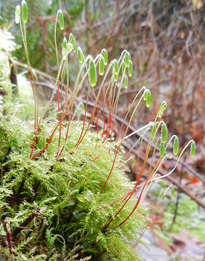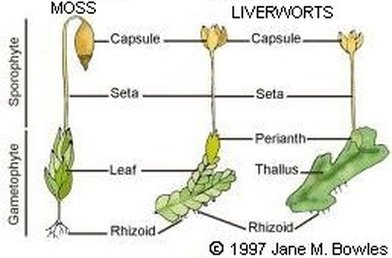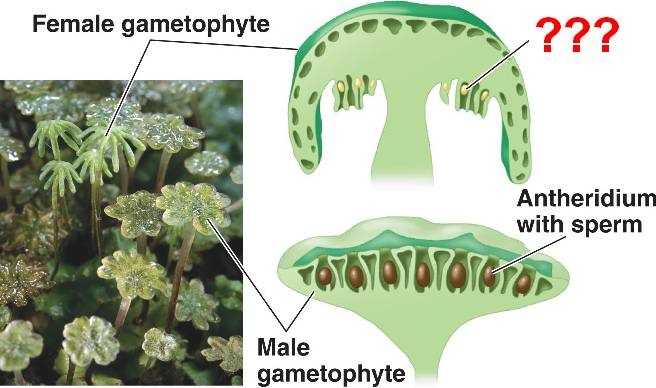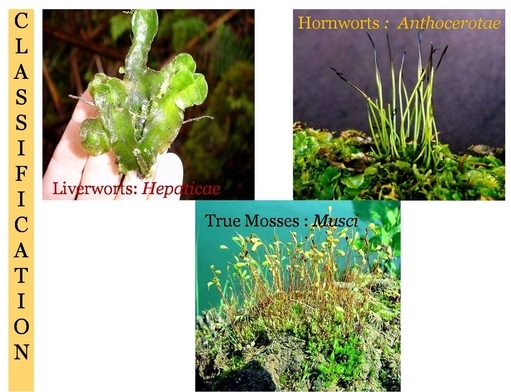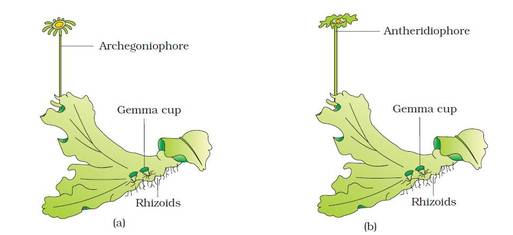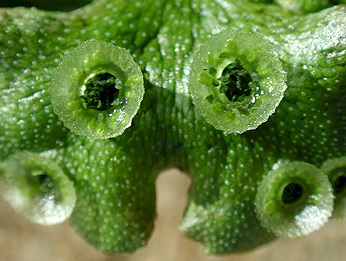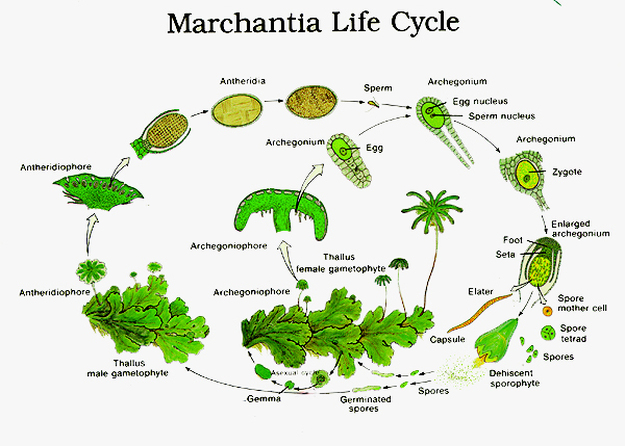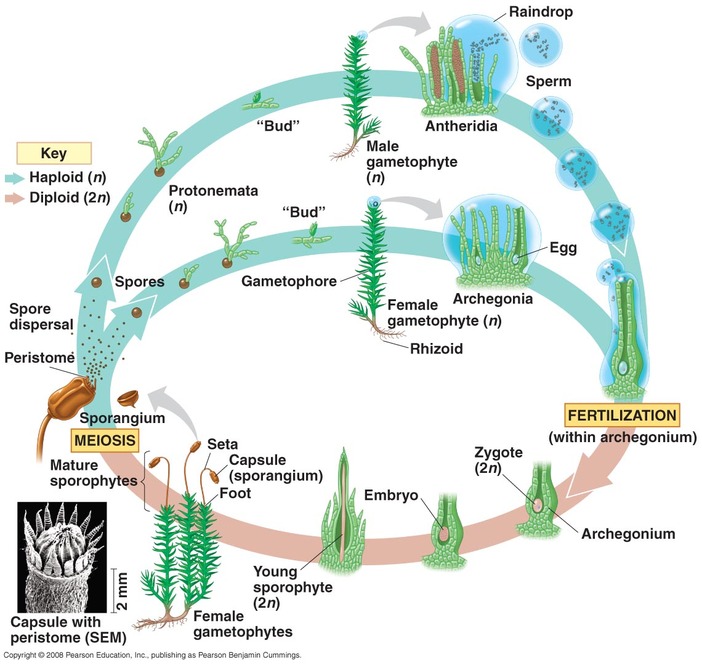ISC 11>CONTENT>2 DIVERSITY OF LIFE>3 KINGDOM-PLANTAE>BRYOPHYTA
BRYOPHYTA:
- Characteristics, classification into liverworts and mosses.
- Life cycle of Funaria with reference to alternation of generations. (Emphasis should be laid on gametophyte and sporophyte stages.)
CLASS PRESENTATION
INTRODUCTION
|
GENERAL CHARACTERISTICS
- Gametophytic and sporophytic phases are present in the life cycle of bryophytes and both these phase are morphologically distinct.
- The gamtophytic phases is more conspicious longer lived, independent green and branched whereas the sporophytic phase is short lived and completely dependent upon the gametophyte.
- In primitive forms, liverworts, the gametophytic plant body is prostrate and thalloid.
- In advanced form, mosses, the gametophytic plant body is erect, into the stem (axis), lateral appendages (leaves) and rhizoids (root).
- True roots are absent and the function of anchorage and absorption is performed by filamentous structures, known as rhizoids.
- The plant body is composed of parenchymatous cells only and lacks fully differentiated xylem and phloem.
- They reproduce by vegetative and sexual methods.
- Vegetative multiplication takes place by decay and death of old parts of thallus, by adventitious branches or by special structures like tubers or gemmae.
- Sexual reproduction is of oogamous type.
- The male sex organs, known as antheridia, are stalked and globose in shape. They have an outer sterile one cell thick jacket, which surrounds a solid mass of fertile cells, the androcytes. The androcyte eventually metamorphoses into a motile biflagellate antherozoid.
- The female sex organ, known as archegonium, is a flask shaped structure, having a basal swollen venter and somewhat more slender elongate upper part, the neck.The venter and neck are surrounded by a jacket of sterile cells.
- Water is essential for fertilization. Flagellated antherozoid fuse with egg to form a diploid zygote.
- The zygote does not have any resting period and it divides immediately after fertilization.
- Zygote divides and forms embryo within the venter of the archegonium. Zygotes do not undergo reduction division immediately. They produce a multicellular body called a sporophyte.
- The sporophyte, developing from the embryo, is a simple structure without rhizoids, stem and leaves. It is completely dependent upon the gametophyte .
- The sporophyte is a projecting structure, differentiated into foot, seta and capsule. In some members the sporophyte is represented by either only by capsule or by foot and capsule.
- The sporogenous cells present in the capsule form many haploid spores after reduction division.
- All spores are similar in shape and size.
- Under favorable conditions, the spore either forms a filamentous germ tube which divides to form a young gametophyte or give rise to a protonema as in mosses.
- The protonema bears buds which develop into erect gametophores.
PLANT BODY REPRODUCTIVE ORGAN
CLASSIFICATION
- Bryophytes are divided into liverworts, hornworts and mosses.
- Liverworts : Hepaticae
- Hornworts : Anthocerotae
- Mosses : Bryopsida (Musci)
LIVERWORTS
- The liverworts grow usually in moist, shady habitats such as banks of streams, marshy ground, damp soil, bark of trees and deep in the woods.
- The plant body of a liverwort is thalloid, e.g., Marchantia. The thallus is dorsiventral and closely appressed to the substrate.
- Asexual reproduction in liverworts takes place by fragmentation of thalli, or by the formation of specialised structures called gemmae (sing. gemma).
- Gemmae are green, multicellular, asexual buds, which develop in small receptacles called gemma cups located on the thalli. The gemmae become detached from the parent body and germinate to form new individuals.
- During sexual reproduction, male and female sex organs are produced either on the same or on different thalli.
- The sporophyte is differentiated into a foot, seta and capsule.
- After meiosis, spores are produced within the capsule. These spores germinate to form free-living gametophytes.
MOSSES
- The predominant stage of the life cycle of a moss is the gametophyte which consists of two stages.
- The first stage is the protonema stage, which develops directly from a spore. It is a creeping, green, branched and frequently filamentous stage.
- The second stage is the leafy stage, which develops from the secondary protonema as a lateral bud. They consist of upright, slender axes bearing spirally arranged leaves.
- They are attached to the soil through multicellular and branched rhizoids. This stage bears the sex organs.
- Vegetative reproduction in mosses is by fragmentation and budding in the secondary protonema.
- In sexual reproduction, the sex organs antheridia and archegonia are produced at the apex of the leafy shoots. After fertilisation, the zygote develops into a sporophyte, consisting of a foot, seta and capsule.
- The sporophyte in mosses is more elaborate than that in liverworts. The capsule contains spores. Spores are formed after meiosis. The mosses have an elaborate mechanism of spore dispersal.
- Common examples of mosses are Funaria, Polytrichum and Sphagnum
- Moss (Funaria) life cycle : Animation
IMPORTANCE OF BRYOPHYTES
ANIMATION: Importance of bryophytes
- Peat : Sphagnum grows in semi-aquatic or submerged conditions in acidic marshes where there is least decay. The older dead parts of this moss and other marshy plants are slowly carbonized, compressed and fossilized over thousands of years to produce a dark spongy mass called peat. Peat is dried, compressed and cut into pieces and is used as fuel. It is mixed in sandy soil to improve its water holding capacity and as a source of organic matter. Peat is distilled and fermented to yield many chemicals.
- In Nursery and Transportation : Sphagnum, commonly called bog moss or peat moss generally occurs at the edges of bogs, swamps, waterfalls etc. It can absorb large amounts of water i.e., upto 18 times its weight. It is used to keep moist the cut plant parts during transportation and propagation in nursery.
- Food : Mosses constitute food for many small animals such as birds, eg. Grouse Chicken feed on capsules of Bryum and Polytrichum.
- Medicinal Use : Marchantia polytricum has medicinal properties to cure liver and lung infections. Sphagnol, a distillate is used to cure skin infections. Decoction of Polytrichum communs is believed to dissolve kidney and gall bladder stones. During the second World War, Sphagnum was used in surgical dressing as an antiseptic.
- Ecological Importance : Mosses along with lichens are the first organisms to colonise rocks and hence, are of great ecological importance. They decompose rocks making the substract suitable for the growth of higher plants.
- Soil Conservation : Mosses from dense mats on the soil which reduce the impact of falling rain and prevent soil erosion.
DIFFERENCES BETWEEN LIVERWORTS AND MOSSES
DIFFERENCE BETWEEN SPOROPHYTE AND GAMETOPHYTE
|
|
|
